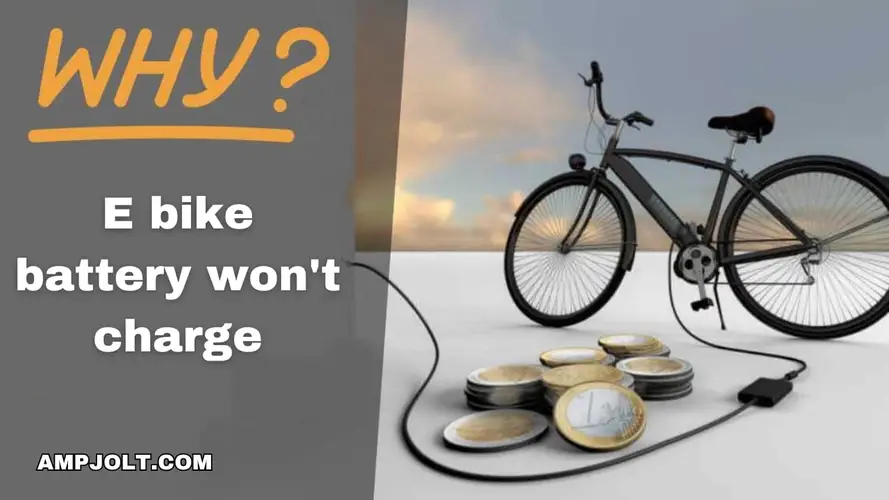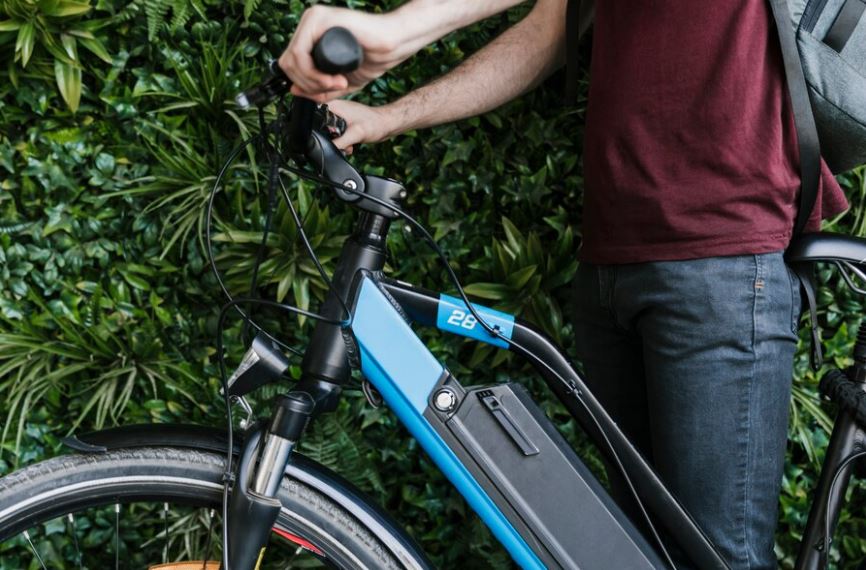How to connect 4 12v batteries to make 48v?
April 14, 2018

E-bikes have revolutionized the cycling world, providing an eco-friendly and efficient means of transportation. However, encountering issues with the e-bike battery not charging can be frustrating.
Several factors could prevent an e-bike battery from charging, including age-related wear, charger issues, loose connections, BMS malfunctions, extreme temperatures, deep discharge, faulty cells, or software problems. Identifying the specific cause requires systematic troubleshooting and, in some cases, professional inspection to resolve the issue and restore proper charging functionality.
In this comprehensive guide, we'll explore the potential reasons behind this problem and guide you through troubleshooting steps to get your e-bike back on the road.
Over time, e-bike batteries experience wear and tear, leading to reduced charging capacity. If your battery is several years old, it may be reaching the end of its lifespan, and replacement might be necessary.
Faulty or damaged chargers can impede the charging process. Inspect the charger for visible damage, and if possible, test it with another e-bike or battery to rule out charger-related issues.
The BMS is crucial for managing the battery's functions, including charging. A malfunctioning BMS can prevent the battery from accepting a charge. Professional inspection may be required to assess and repair the BMS.
Loose or damaged connections between the battery, charger, or e-bike components can disrupt the charging process. Ensure all connections are secure, and inspect cables for any signs of damage.
Charging a battery in extreme temperatures, either too hot or too cold, can affect its performance. Ideally, charge your e-bike battery in a moderate-temperature environment.
Allowing the battery to discharge before recharging can lead to a phenomenon called "deep discharge," which might make the battery unresponsive to charging attempts. Avoid deep discharges whenever possible.
Individual cells within the battery pack may fail over time, causing the entire battery to malfunction. Testing and replacing faulty cells might be necessary for restoring functionality.
Some e-bike systems have software or firmware that controls charging processes. Updating or resetting this software may resolve charging issues. Consult your e-bike manufacturer's guidelines for any available updates.

Use a multimeter to check the Voltage of your e-bike battery. A significantly low voltage may indicate a deep discharge or faulty cells. Consult your battery specifications for the appropriate voltage range.
Examine the charger for damage and ensure that all connections between the charger, battery, and e-bike are secure. Clean any dirt or debris from connection points.
Plug the charger into a different electrical outlet to rule out potential issues with the power source. Ensure the outlet is functional by testing it with another device.
If you suspect BMS issues, bypassing it temporarily may help determine if it's causing them. However, this should only be done by professionals, as it involves technical expertise.
Charge your e-bike battery in a moderate-temperature environment. Avoid exposing the battery to extreme heat or cold, affecting charging efficiency.
Refer to your e-bike and battery manufacturer's guidelines for troubleshooting and maintenance. Some systems may have specific procedures for resolving charging issues.
If troubleshooting steps don't resolve the problem, seek professional assistance. E-bike technicians or the manufacturer's customer support can diagnose and address more complex issues.
If your e-bike battery is old and showing signs of degradation, replacing it might be the most effective solution. Ensure the replacement battery is compatible with your e-bike model.
Checking whether your e-bike battery is faulty involves a systematic approach to identifying potential issues. Here's a guide on how to assess the health of your e-bike battery:
Use a multimeter to measure the Voltage of your e-bike battery. A fully charged battery should be within a specific voltage range, as indicated in your battery's specifications. If the Voltage is significantly lower than the expected range, it may indicate a potential problem.
Examine the exterior of the battery for any visible damage or irregularities. Look for bulges, leaks, or deformities in the battery casing. Physical damage can be an indication of internal issues.
Consider the age of your e-bike battery. Lithium-ion batteries, commonly used in e-bikes, have a limited lifespan of 2-5 years, depending on factors like usage and charging habits. If your storm is approaching the end of its lifespan, it may be more prone to issues.
Pay attention to how the battery behaves during the charging process. It may indicate a fault if the battery doesn't reach a full charge, takes an unusually long time, or shows inconsistent charging patterns.
Assess the temperature of the battery during and after charging. Overheating during charging or discharging can be a sign of internal problems. Ensure that the battery remains within the recommended temperature range.
If you can access another compatible e-bike, consider testing your battery on that bike. If the battery charges and operates correctly on a different e-bike, it may suggest that the issue lies with the original e-bike's components, such as the controller or wiring.
Some e-bike batteries have a BMS that monitors and manages the battery's functions. Consult the BMS data, if available, to identify any irregularities in cell voltages, temperatures, or charging cycles.
If you cannot identify the issue or suspect a complex internal problem, seek professional inspection. E-bike technicians or the manufacturer's customer support can perform in-depth diagnostics to pinpoint and address the fault.
If individual cells within the battery pack are replaceable, you might consider replacing only the faulty cells. This can be a cost-effective solution compared to replacing the entire battery. It would help if you also read How do I revive my electric bike battery?
Regularly monitor the overall Capacity of your e-bike battery. If you notice a significant and consistent decrease in the battery's ability to hold a charge, it may indicate deterioration.
By systematically assessing these aspects, you can gain valuable insights into the health of your e-bike battery. If issues persist or if you're unsure about the diagnosis, seeking professional assistance is advisable for a thorough and accurate assessment.
E-bike battery problems can be a source of frustration for riders, impacting the convenience and efficiency of electric-powered cycling. Here are common e-bike battery issues and insights on how to address them:
As e-bike batteries age, their capacity diminishes, resulting in a reduced range per charge. Regularly monitor your battery's Capacity and consider a replacement if it significantly decreases over time.
Charging issues can arise due to faulty chargers, loose connections, or incompatibility. Inspect the charger, ensure secure connections, and use a compatible charger to avoid charging problems.
Unexpected power loss during rides may indicate a deep discharge, faulty cells, or a malfunctioning Battery Management System (BMS). Avoid deep shots, monitor cell health, and seek professional help for BMS issues.
Excessive heat during charging or discharging can damage the battery. Charge your e-bike battery in a moderate-temperature environment, avoid continuous high-demand usage, and monitor for signs of overheating.
Individual cells within the battery pack may fail, leading to overall battery malfunctions. Regularly check cell health; if necessary, replace faulty cells or consider a new battery.
The Battery Management System is critical for proper battery function. If the BMS malfunctions, it can impact charging, discharging, and overall performance. A professional inspection is advisable to diagnose and address BMS issues.
Charging or using the e-bike in extreme temperatures can affect battery performance. Optimal charging and usage occur within a moderate temperature range to avoid strain on the battery.
Some e-bikes have software or firmware controlling charging processes. Keep your system updated, reset if necessary, and follow manufacturer guidelines to address potential software-related issues.
Ensure your charger is compatible with your e-bike battery. Using an incorrect or damaged charger can lead to charging failures and potential damage to the battery.
E-bike batteries have a limited lifespan. If your battery is several years old and exhibiting signs of wear, such as reduced Capacity or difficulty holding a charge, consider a replacement for optimal performance.
Regular maintenance, timely replacement when needed, and adherence to proper charging practices can mitigate many e-bike battery problems. If issues persist, consulting with e-bike technicians or the manufacturer's support can provide tailored solutions and extend the life of your e-bike battery.
Encountering charging issues with your e-bike battery can be perplexing, but understanding the potential causes and following systematic troubleshooting steps can often lead to a solution. From checking connections to assessing battery health, addressing the issue promptly ensures a smoother and more enjoyable e-biking experience. If in doubt, consult with professionals specializing in e-bike maintenance and seek guidance from the manufacturer. With the right approach, you can get your e-bike back on the road, ready to take on new adventures.
E-bike batteries may not charge for various reasons, including age, charger issues, loose connections, BMS malfunctions, extreme temperatures, deep discharge, faulty cells, or software/firmware problems.
Inspect the charger for visible damage, test it with another e-bike or battery if possible, and ensure secure connections. If issues persist, consider replacing the charger.
Yes, extreme temperatures (either too hot or too cold) can impact the charging efficiency of e-bike batteries. Charge the battery in a moderate-temperature environment.
Professionals should only bypass the BMS, as it involves technical expertise. Consult with e-bike technicians or the manufacturer for guidance.
The lifespan of e-bike batteries varies, but they generally last 2-5 years, depending on usage and maintenance. Consider replacement if the battery shows signs of wear, significantly reduced Capacity or fails to charge.
While most e-bike chargers are designed for standard outlets, ensuring the outlet is functional is essential. If charging issues persist, try a different outlet and check the charger's compatibility.
Some e-bike systems have software or firmware that controls charging processes. Check with your e-bike manufacturer for any available updates or recommended procedures for addressing software-related issues.
Comments
Write a comment